Which planet is gaseous?
A. Mercury
B. Neptune
C. Sun
D. Moon
Neptune
Earth's Rotation is how long and gives us one what?
24 hours and 1 day and night
What tool changed human's belief on what is in the center of our solar system?
The telescope
The Moon completes an orbit around Earth about once a month. Which two statements best explain why the Moon stays in orbit around Earth?
A. A magnetic attraction exists between the Moon and Earth.
B. A force of motion causes Earth to push outwardly on the Moon.
C. A force of attraction due to Earth’s mass pulls the Moon toward Earth.
D. A repelling force keeps the Moon moving in a straight line around Earth.
E. A force of gravitational pull pulls the moon toward Earth.
C & E
True or False.
The Moon rotates around the Earth while the Earth is revolving around the Sun.
False.
What phase occurs day 1 of the lunar cycle? Is this phase between the Earth and Sun or on the opposite of Earth from the Sun?
New Moon
Between
A. Mercury
B. Venus
C. Mars
D. Jupiter
A student observed that the appearance of the constellations in the night sky changed over a year. Circle one word or phrase in each set of options to best explain the reason for the change observed by the student.
The constellations appear to change ( size / location / brightness / stars ) throughout the year because Earth ( rotates on an axis / changes distances from the stars / revolves around the Sun / changes seasonal weather ) over time.
Location
Revolves around the Sun
Does the image represent the Helio or Geo Model of the Solar System? Is this the correct model? Is the 1st or 2nd model that scientists believed to be true?
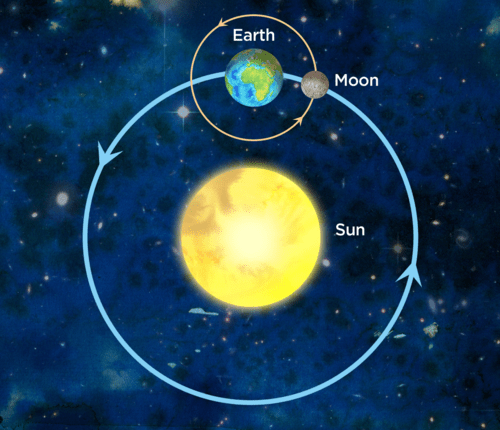
Heliocentric
NO
1st
Which letter represents where the moon would be located during a lunar eclipse?
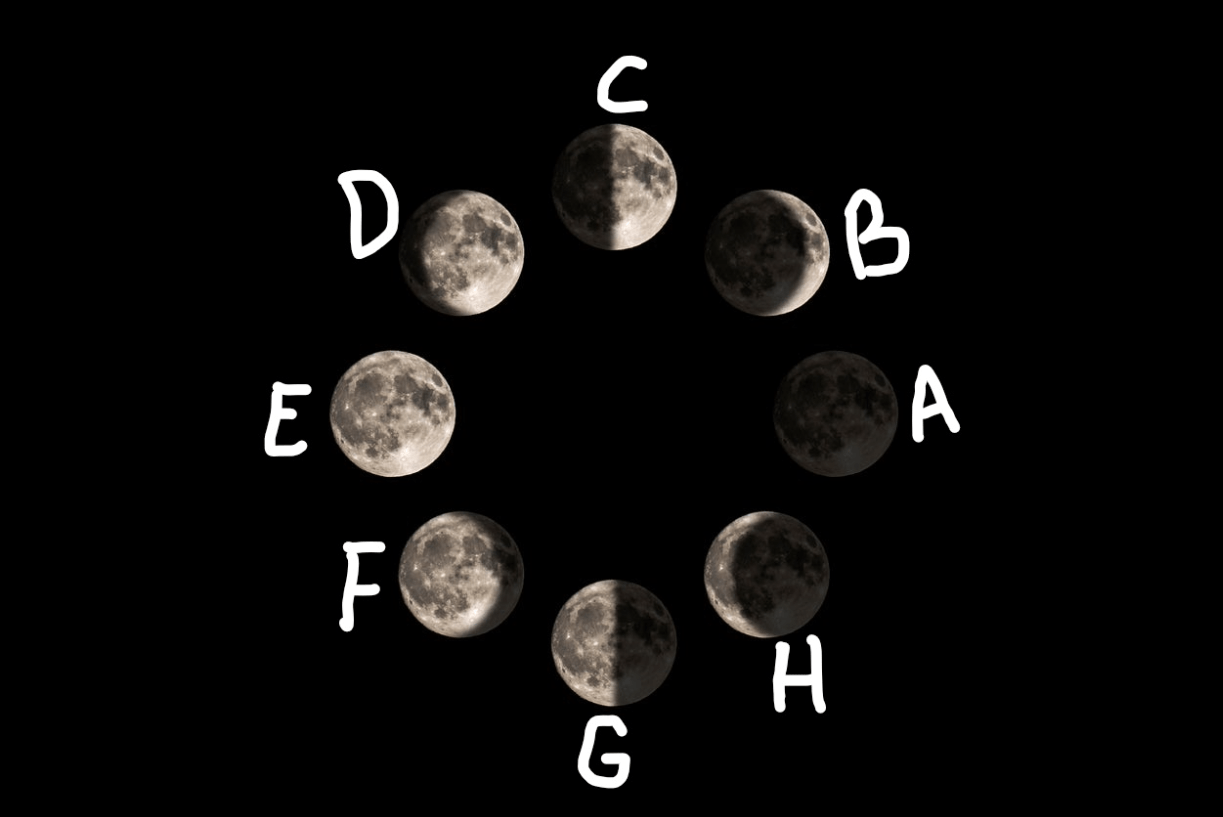
E
Image you are standing where the purple arrow is at? Is it day or night? Winter or Summer?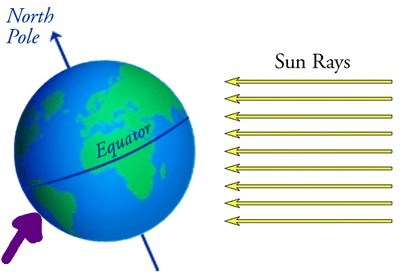
Night time in the Winter
About a month
Inner planets:
Mercury
Venus
Earth
Mars
In the winter night sky above Mississippi, the constellation Orion, the hunter, can be observed. The three stars of Orion’s belt are easy to identify. Orion can be seen until May in Mississippi. Which statement best explains why Orion cannot be seen during the summer in Mississippi?
A. The orbit of Earth on its axis shifts Orion to the daytime sky.
B. The rotation of Earth on its axis shifts Orion to the daytime sky.
C. The orbit of Earth around the Sun places the Sun between Earth and Orion.
D. The rotation of Earth around the Sun places the Sun between Earth and Orion.
C
Locating the North Star has helped people determine direction throughout history. Its northern position in the sky stays the same. Sailors used it to help navigate their ships across open water. Later, people began to use compasses for navigating ships. A student claims that using a compass results in better navigation than locating the North Star. Which statement provides the best evidence to support the student’s claim?
A. A compass needle moves as the user changes direction.
B. A compass can be used to find direction during the daytime.
C. A compass needle must be made of a magnetic iron material.
D. A compass allows the user to find directions other than north.
B. A compass can be used to find direction during the daytime.
Because of Galileo using a telescope to study space, scientists learned that the Sun's large amount of _____ is responsible for keeping the planets on their _________ _______ which circles around the ________ because it keeps a ____________ pull on the planets.
Mass
Orbital path/ revolution
Sun
Gravitational
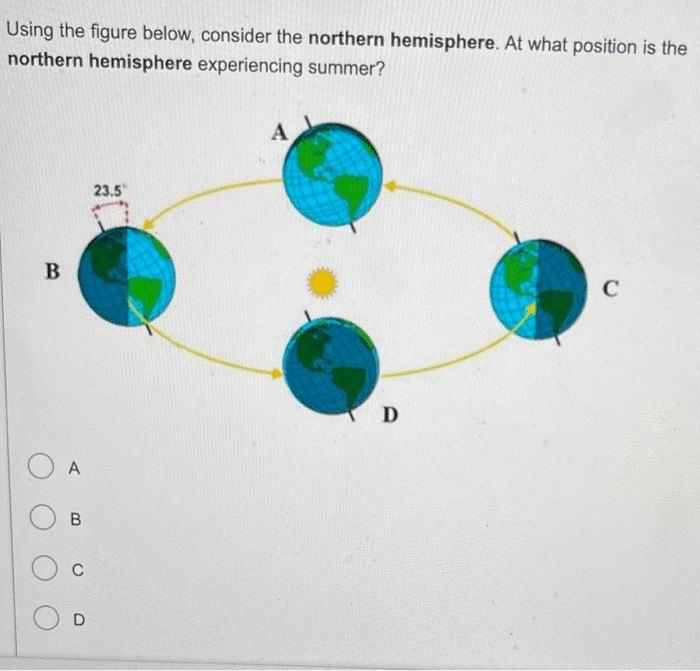
The North Star is the brightest star in the night sky.
What is our daytime star? Does it appear to be brighter than the North Star? Explain your answer.
The Sun. Yes. It is closer to us.
Because they are closer to the Sun
What gives us a revolution and how long is it?
One complete orbit around the Sun. It takes 365 days which completes a year.
Humans’ understanding of our solar system has changed over time. Scientists throughout history have made models based on observations. Which statement best represents Ptolemy’s model of the solar system?
A. Like Aristotle, Ptolemy placed Earth at the center of the solar system.
B. Like Aristotle, Ptolemy placed the Sun at the center of the solar system.
C. Like Copernicus, Ptolemy placed Earth at the center of the solar system.
D. Like Copernicus, Ptolemy placed the Sun at the center of the solar system.
A. Like Aristotle, Ptolemy placed Earth at the center of the solar system.
Which number represents where a waxing crescent would be?
2
The Southern Hemisphere is experiencing summer.
The Southern Hemisphere is tilted ( toward / away from ) the Sun, and the Sun appears ( higher / lower ) in the sky in the Southern Hemisphere. This causes temperatures to be ( cooler / warmer ) than in the Northern Hemisphere. The hours of day time hours are (longer/shorter) during this time.
Toward
Higher
Warmer
Longer
Using a telescope, we can clearly see the size of certain celestial objects in relation to others. Put the following celestial objects in order from greatest mass to least amount of mass
Earth
Jupiter
Moon
Sun
Mercury
Pluto
Sun, Jupiter, Earth, Mercury, Pluto
A student made a model of the five planets that are closest to the Sun. The student needs to add more information to the model. Sun Solar System Model Which two steps should the student perform next?
A. Label the four planets closest to the Sun as gas planets. Label the largest planet as Mars.
B. Label the four planets closest to the Sun as rocky planets. Label the largest planet as Jupiter.
C. Label the planet that is farthest from the Sun as a gas planet. Label the smallest planet as Venus.
D. Label the planet that is farthest from the Sun as a rocky planet. Label the smallest planet as Mercury.
B. Label the four planets closest to the Sun as rocky planets. Label the largest planet as Jupiter.
Which planet has a longer revolution between Mercury and Saturn? Explain.
Saturn because it is far away from the Sun, so it takes longer to complete its orbital path.
A student made a list of ideas that scientists have had over time about the solar system. Record the letter of each sentence in the correct position in the list to show the order in which the ideas were accepted by the scientific community.
Idea W: Earth is just one planet orbiting one star which is a small part in a vast (much larger) universe.
Idea X: Earth is the center of the universe.
Idea Y: The Sun is the center of the solar system
X
Y
W
Which phase of the lunar cycle would be where the green circle is?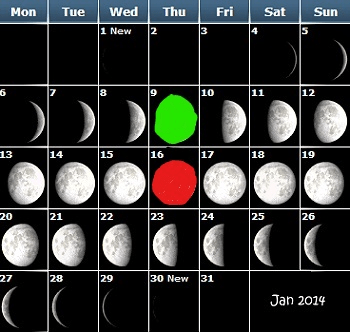
1st quarter
Because the middle of the Earth, where the equator is at, receives more direct Sunlight through out the year than the top and bottom ends of the Earth.
Ocean explorers of the past used different methods than modern ocean explorers to navigate long distances. The explorers took careful measurements of their surroundings and recorded them in logbooks. Which measurement best helped these ocean explorers navigate long distances?
A. wind direction changes
B. air temperature changes
C. changes in the appearance of the locations of stars
D. changes in the apparent size of the Sun
C. changes in the appearance of the locations of stars